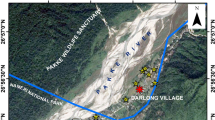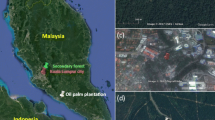Abstract
This study provides the primary information about the population of Pteropus giganteus, a mega fruit-bat, having a permanent roost in avenue plantations of Delhi, India. These avenue plantations of Lutyens’ Delhi have a variety of tree species which serve as habitats for both roosting and foraging of fruit-eating bats, P. giganteus. These avenue trees comprise of species like Terminalia arjuna, Ficus microcarpa, Syzigium cumini, Polyalthia longifolia and Putranjiva roxburghii. The Indian flying fox (P. giganteus) was observed roosting on nine species of avenue trees in Delhi in the present study, which was undertaken for a period of 3 years from April 2014 to June 2017. In this study period, the peak colony size was observed in May, 2014 (1660 individuals). The flying foxes use 9 species of avenue trees for roosting, where the largest colony size was observed on T. arjuna. This zone is the only roosting location of the Indian flying fox in Delhi, which plays an important role in seed dispersal and pollination. The colony size was largest during the spring-summer months which showed a gradual decrease with the decline in temperature during winters. Although, year round T. arjuna had the maximum number of individuals from the colony whereas Cassia fistula, Delonix regia and Bombax ceiba had the least. The result provides the scope for an uncharismatic species beyond protected area and organismal biology, towards linkages of functional landscapes and urban ecosystem services. With proper monitoring, this area has huge potential to be converted into a ‘Conserved Roosting site’ of P. giganteus.
Similar content being viewed by others
References
Bates, P.J.J., and D.L. Harrison. 1997. Bats of the Indian Subcontinent, 258. Sevenoaks: Harrison Zoological Museum.
Bhalla, P., and P. Bhattacharya. 2015. Urban biodiversity and greenspaces in Delhi: A case study of new settlement and Lutyens’ Delhi. Journal of Human Ecology 51(12): 83–96.
Bhatnagar, C., and R. Salvi. 2011. Sites and roosting ecology of bats of Udaipur District, Rajasthan. Small Mammal Mail, Bi-Annual Newsletter of CCINSA & RISCINSA 3: 31–35.
Bolund, P., and S. Hunhammar. 1999. Ecosystem services in urban areas. Ecological Economics 29: 293–301.
Brosset, A. 1962a. The bats of Central and Western India. Part I. Journal of Bombay Natural History Society 59(1): 1–57.
Brosset, A. 1962b. The bats of Central and Western India. Part II. Journal of Bombay Natural History Society 59(2): 583–624.
Brosset, A. 1962c. The bats of Central and Western India. Part III. Journal of Bombay Natural History Society 59(3): 707–746.
Burland, T.M., and J.W. Wilmer. 2001. Seeing in the dark: Molecular approaches to the study of bat populations. Biology Review 76: 389–409.
Chakravarthy, A.K., and H.M. Yeshwanth. 2008. Status of roost of Indian flying fox (Pteropus giganteus Brunnich) in Karnataka, South India. Bat Net CCINSA Newsletter 9: 16–18.
Dey, S., U. Roy, and S. Chattopadhyay. 2013. Distribution and abundance of three populations of Indian flying fox Pteropus giganteus from Purulia District of West Bengal, India. Taprobanica: The Journal of Asian Biodiversity 5(1): 60–66.
Dookia, S., and R. Mishra. 2018. First record of Asiatic Lesser Yellow House Bat, Scotophilus kuhlii Leach, 1821 (Mammalia: Chiroptera: Vespertilionidae) from Delhi, India. Journal on New Biological Reports 7(1): 28–33.
Dookia, S., and J.R. Tak. 2004. Status and distribution of Indian flying fox (Pteropus giganteus Brunnich) in Thar Desert of Rajasthan. Bat Net CCINSA Newsletter 5(1): 7–8.
Fenton, M.B., and N.B. Simmons. 2014. Bats: A world of science and mystery, 303. Chicago: University of Chicago Press.
Forest Survey of India .2015. Forests and tree resources in states and union territories. India state of forest report. 288 pp.
Holland, R.A., and M. Wikelski. 2009. Studying the migratory behavior of individual bats: Current techniques and future directions. Journal of Mammalogy 90(6): 1324–1329. https://doi.org/10.1644/09-MAMM-S-086R2.1.
Krishen, P. 2006. Trees of Delhi, A field guide, 360. Ltd: Dorling Kindersley (India) Pvt.
Kumar, J., and A. Kanaujia. 2015. Distribution and population status of fruit-bat (Pteropus giganteus) in district Lakhimpur-Kheri, Uttar Pradesh, India. G-Journal of Environmental Science and Technology 3(3): 23–28.
Kunz, T.H., M. Betke, N.I. Hristov, and M. Vonhof. 2009. Methods for assessing colony size, population size, and relative abundance of bats. In Ecological and behavioral methods for the study of bats, 2nd ed, ed. T.H. Kunz and S. Parsons, 133–157. Baltimore: Johns Hopkins University Press.
Lane, D.J.W., T. Kingston, and B.P.Y.H. Lee. 2006. Dramatic decline in bat species richness in Singapore, with implications for Southeast Asia. Biological Conservation 131: 584–593.
Manandhar, S., S. Thapa, T.K. Shrestha, R. Jyakhwo, W. Wright, and A. Aryal. 2017. Population status and diurnal behaviour of the Indian flying fox Pteropus giganteus (Brunnich, 1782) in Kathmandu Valley, Nepal. Proceedings of Zoological Society 9(17): 1–13. https://doi.org/10.1007/s12595-017-0219-x.
Mathur, V., Y.S. Priya, H. Kumar, and V. Elangovan. 2012. Reproductive behavior and population dynamics of Indian flying fox (Pteropus giganteus). Journal of Threatened Taxa 4(7): 2699–2704.
Mickleburgh, S., K. Waylen, and P. Racey. 2009. Bats as bushmeat: A global review. Oryx 43(2): 217–234.
Mickleburgh, S.P., A.M. Hutson, and P.A. Racey. 2002. A review of the global conservation status of bats. Oryx 36: 18–34.
Mildenstein, T., I. Tanshi, and P.A. Racey. 2016. Exploitation of bats for bushmeat and medicine. In Bats in the anthropocene: Conservation of bats in a changing world, ed. C.C. Voight and T. Kingston, 325–375. Berlin: Springer.
Mishra, R., and S. Dookia. 2015. Bats of Delhi. Small Mammal Mail 7(1): 15–17.
Molur, S., S. Mistry, S. Walker, and S. Kandula. 2005. Project PteroCount. South Asian Bat Monitoring Programme . Pteropus giganteus Population Monitoring Project. CCINSA-Zoo Outreach Organization.
Molur, S., Srinivasulu, C., Bates, P., and Francis, C. 2008. Pteropus giganteus. The IUCN Red List of Threatened Species 2008: e.T18725A8511108. https://doi.org/10.2305/iucn.uk.2008.rlts.t18725a8511108.en.
Rajeshkumar, S., C. Raghunathan, and K. Venkataraman. 2013. Observation on electrocution of flying fox Pteropus giganteus in Andaman islands and conservation strategies. Journal of the Andaman Science Association 18(2): 213–215.
Roberts, B.J., C.P. Caterall, P. Eby, and J. Kanowski. 2012. Long-distance and frequent movements of the flying-fox Pteropus poliocephalus: Implications for management. PLoS ONE 7(8): 42532. https://doi.org/10.1371/journal.pone.0042532.
Saikia, U., G. Csorba, and M. Ruedi. 2017. First record of Hypsogo joffrei (Thomas, 1915) and the revision of Philetor brachypterus (Temminck, 1840) specimens (Chiroptera: Vespertilionidae) from the Indian Subcontinent. Revue Suisse de Zoologie 124(1): 83–89.
Senacha, K.R., and S. Dookia. 2013. Geoffroy’s Trident leaf-nosed bat, Asellia tridens (Geoffroy, E. 1813) from India. Current Science 105(1): 21–22.
Senthikumar, K., and G. Marimuthu. 2012. Tree roosting fruit bats (Chiroptera: Pteropodidae) in Southern Tamil Nadu. International Journal of Applied Bioresearch 14: 4–10.
Singaravelan, N., G. Marimuthu, and P.A. Racey. 2009. Do fruit-bats deserved to be listed as vermin in the Indian Wildlife (Protection) and Amended acts? A critical review. Oryx 43(4): 608–613. https://doi.org/10.1017/S0030605309990391.
Sinha, N.K., and J.P. Sati. 1997. Mammalia. In: Fauna of Delhi, The Director (ed.), Zoological Survey of India, pp. 823–840.
Statistical Package for Social Sciences. 2007. SPSS for windows, version 20.0. Chicago: SPSS Inc.
Srinivasulu, C., and B. Srinivasulu. 2001. Bats of the Indian subcontinent. Current Science 80(11): 1378–1380.
Srinivasulu, C., and B. Srinivasulu. 2007. Bats of Delhi: An update. BAT NET-CCINSA Newsletter 8(1–2): 30–31.
Srinivasulu, C., P.A. Racey, and S. Mistry. 2010. A key to the bats (Mammalia: Chiroptera) of South Asia. Journal of Threatened Taxa 2(7): 1001–1076.
Teeling, E.C., M.S. Springer, O. Madsen, P. Bates, S.J. O’Brien, and W.J. Murphy. 2005. A molecular phylogeny for bats illuminates biogeography and the fossil record. Science 307: 580–584.
Thong, V.D., X. Mao, G. Csorba, P. Bates, M. Ruedi, N.V. Viet, D.N. Loi, P.V. Nha, O. Chachula, T.A. Tuan, N.S. Truong, D. Fukui, V.T. Tu, and U. Saikia. 2018. First Records of Myotis altarium Chiroptera: Vespertilionidae from India and Vietnam. Mammal Study 43(1): 1–7.
Acknowledgements
The authors are thankful to the Mr. A.K. Shukla, Chief Conservator of Forests and Chief Wildlife Warden, Govt. of National Capital Territory of Delhi, for providing essential permits to conduct this study. Special thanks are due to Mr. Priyanshu Joshi, Dept. of Forests and Wildlife, Govt. of N.C.T. of Delhi for all the help during the study. The authors thank the Ministry of Home Affairs and Ministry of Information and Broadcasting, Govt. of India, for granting permission to conduct surveys in the Lutyens’ Bungalow Zone. We acknowledge Mr. Souvik Dutta, Indian Statistical Institute, Kolkata, in assisting with the statistical analysis of the paper. We thank Mr. Pradip Gaur, photographer, Mint Lounge (HT Media), for the photograph of bats used in this paper. We are thankful to Survey of India, Map sale office and New Delhi Municipal Corporation (NDMC), for providing the toposheets of Delhi and NDMC municipality respectively, that have been digitized to prepare maps. RM, SD and PB are thankful to Dean, University School of Environment Management, Guru Gobind Singh Indraprastha University for providing necessary facilities to conduct this study. All authors are also thankful to the two anonymous reviewers for providing valuable comments and useful suggestions to improve the manuscript. RM is thankful to Guru Gobind Singh Indraprastha University for funding this study by the Indraprastha Research Fellowship (IPRF) vide Letter No. 1427/2013. A part of this work was presented in the 3rd International Southeast Asian Bat Conference (SEABCO) held in Sarawak, Malaysia in August 2015. RM is grateful to Southeast Asian Bat Research and Conservation Unit (SEABRU) and Prof. Tigga Kingston for providing travel grant to attend this conference.
Travel Grant
The corresponding author was granted a student’s scholarship to attend the 3rd International Southeast Asian Bat Conference in Malaysia, 2015 by the Southeast Asian Bat Research and Conservation Unit (SEABCRU), where a part of this work was presented.
Funding
The corresponding author received funding from Guru Gobind Singh Indraprastha University, Govt. of N.C.T of Delhi via Indraprastha Research Fellowship (IPRF) (Grant No. 1427/2013).
Author information
Authors and Affiliations
Contributions
RM carried out the field work for the study including data collection and analysis. RM prepared the manuscript. SD and PB revised the manuscript.
Corresponding author
Ethics declarations
Conflict of interest
The authors declare no conflicts of interest.
Human and Animal Rights
This article does not contain any studies with human participants or animals performed by any of the authors. The datasets generated and analyzed during the current study are available from the corresponding author on reasonable request.
Additional information
Publisher's Note
Springer Nature remains neutral with regard to jurisdictional claims in published maps and institutional affiliations.
Rights and permissions
About this article
Cite this article
Mishra, R., Dookia, S. & Bhattacharya, P. Avenue Plantations as Biodiversity Havens: A Case Study of Population Status of the Indian Flying Fox, Pteropus giganteus Brunnich, 1782 and Implications for Its Conservation in the Urban Megacity, Delhi, India. Proc Zool Soc 73, 127–136 (2020). https://doi.org/10.1007/s12595-019-00308-3
Received:
Revised:
Accepted:
Published:
Issue Date:
DOI: https://doi.org/10.1007/s12595-019-00308-3











